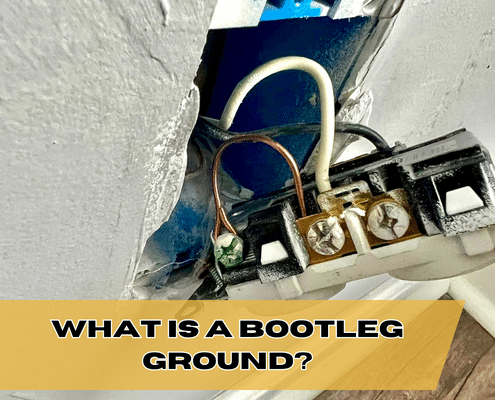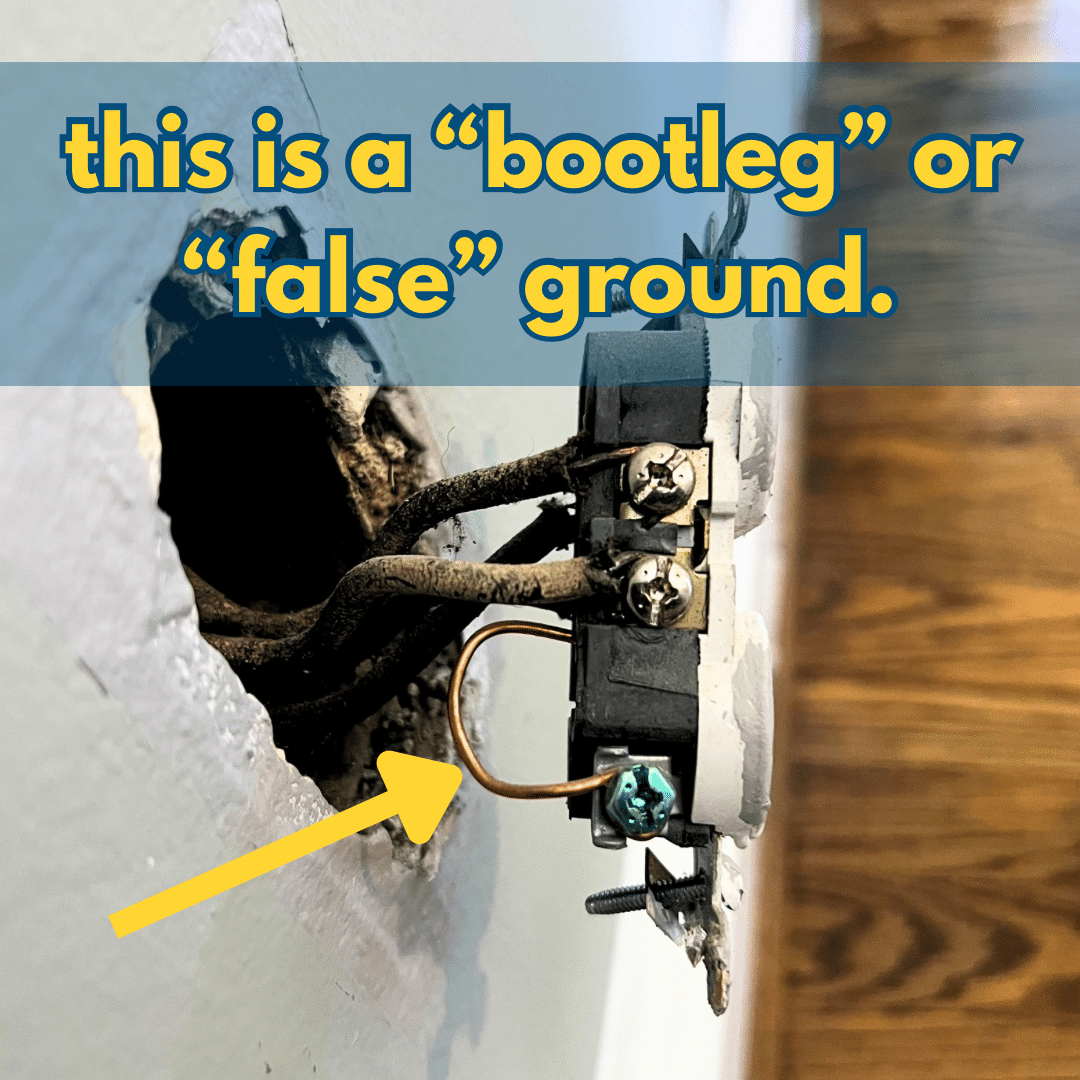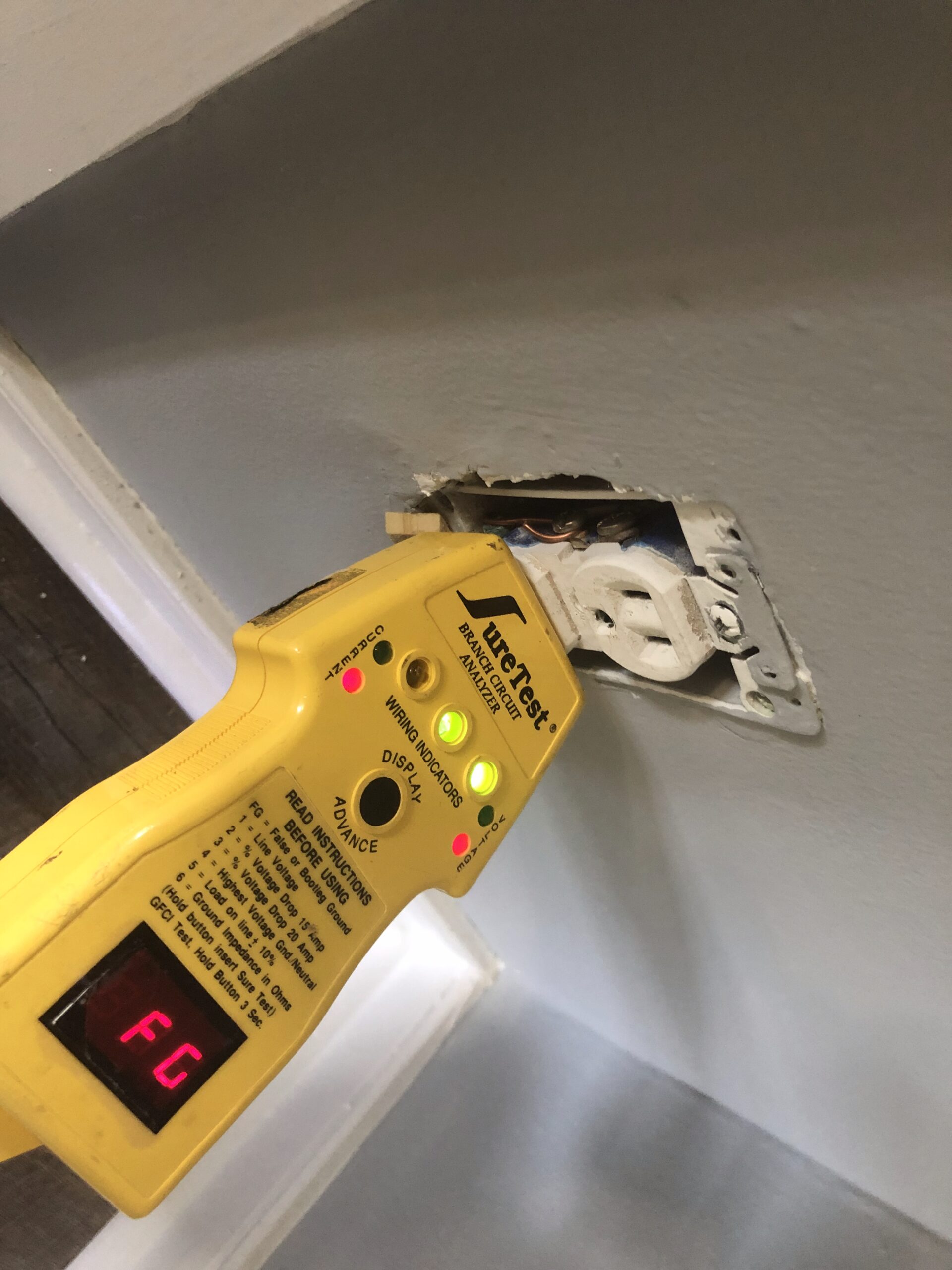4.9 1890+ Google Reviews

The electrical system is one of the most complex and challenging to understand systems in your home. During our home inspections, we often find a problem called "bootleg grounds." So what is a bootleg ground?
A bootleg ground, AKA false ground, is the installation of a jumper wire between the neutral and ground screws. This wiring method will give false readings of correct wiring.
In simpler terms, a jumper wire connects the neutral wire (white wires) to the ground screw (green screw) of a three-prong outlet. The goal is to give a "correct wiring" reading on a 3-light tester.

Richmond has a lot of older homes. My personal inspections have included homes dating back to the 1800s, but the majority have been from the early and mid-1900s. Investors often buy these homes, upgrade them, and then resell them in a short period of time.
Many people call these flips.
When flippers attempt to upgrade the electrical system on an older house, the outcome is typically below par. Upgrading the outlets from two-prong to three-prong receptacles appeals to home buyers. New receptacles are pretty cool, right?
However, without upgrading the wiring from a two-wire system to a three-wire system, there won't be a third wire (the ground wire) to connect to the ground terminal.
Most of the time, they leave out the grounding wire, which is a defect all on its own. You can see how to upgrade two-prong outlets here.
However, sometimes they get sneaky and "bootleg" the ground.
A bootleg ground is when they use a jumper wire that connects the neutral screw to the ground screw. Unfortunately, this wiring method gives a false reading to some testers that the outlet is correctly wired and generally tricks most home inspectors.
First, the proper term for the neutral is the “grounded conductor.” Its function is to return current that has passed through a fixture, such as a light bulb (load), back to the source. During regular operation, there is current flowing through the neutral.
The “ground wires” do not carry any current during regular operation with a properly functioning system. The proper term for what most people commonly describe as a “ground wire” is an equipment grounding conductor (EGC). EGCs bond non-current-carrying equipment such as metal appliance casings (toaster), metal conduit, junction boxes, outlet/switch boxes to the service panel, and the neutrals and EGCs within the panel. If a “hot wire” comes into contact with equipment, the EGC will allow enough current to flow back to the panel and trip the breaker (or blow a fuse). If the EGC were not there, a person contacting the equipment and the ground would complete the circuit.
So let’s say you have a toaster oven (or anything with a metal chassis or frame) plugged into an outlet with a bootleg ground. The metal casing and ground wire connect. However, the ground wire and neutral connect in the bootleg outlet. An unsuspecting user risks electrocution when using the toaster.
Unfortunately, most home inspectors will not catch this during their home inspection. This is because most home inspectors carry a simple three-light electrical tester. They plug the tester into an electrical receptacle, and the three lights will light up in a specific pattern to signify if the wiring is correct or defective.
However, these testers have limits. They are only about $10 after all.
The most significant limitation is that they can only detect one defect. So, for example, three-light testers would not be able to detect reverse polarity and open ground.
They also do not test for bootleg grounds.
A more robust circuit analyzer such as a Suretest circuit analyzer is needed to test for bootleg grounds. These analyzers can also detect reverse polarity bootleg ground wiring.

Some electricians think that bootleg grounds are acceptable. Their theory is that the grounded conductor and the grounding conductor connect in the main panel. Thus, they incorrectly assume that the NEC also allows them to connect in the rest of the electrical system.
The NEC is clear:
250.142 (B) Load-Side Equipment. Except as permitted in 250.30(A)(1) and 250.32(B) Exception, a grounded circuit conductor shall not get used for grounding non–current-carrying metal parts of equipment on the load side of the service disconnecting means or on the load side of a separately derived system disconnecting means or the overcurrent devices for a separately derived system not having a main disconnecting means.
The installation of a jumper wire bonds the grounded and grounding conductors and " create a parallel path for the neutral current which allows neutral current to flow on the neutral conductor and the fault current path."
Repairing a bootleg ground is a simple job. But, unfortunately, you can't just remove all the jumper wires from the receptacles. Removing all the jumper wires leaves the home with ungrounded three-prong receptacles.
The National Electrical Code (NEC) gives us three options for dealing with this situation.
"406.4(D)(2) Non–Grounding-Type Receptacles. Where attachment to an equipment grounding conductor does not exist in the receptacle enclosure, the installation shall comply with (D)(2)(a), (D)(2)(b), or (D)(2)(c).
(a) A non–grounding-type receptacle(s) shall be permitted to replace another non–grounding-type receptacle(s).
(b) A non–grounding-type receptacle(s) shall be permitted to be replaced with a ground-fault circuit interrupter-type of receptacle(s). These receptacles or their cover plates shall be marked "No Equipment Ground." An equipment grounding conductor shall not connect from the ground-fault circuit-interrupter-type receptacle to any outlet supplied from the ground-fault circuit-interrupter receptacle.
(c) A non–grounding-type receptacle(s) shall be permitted to be replaced with a grounding-type receptacle(s) where supplied through a ground-fault circuit interrupter. Where grounding-type receptacles get power through the ground-fault circuit interrupter, grounding-type receptacles or their cover plates shall be marked "GFCI Protected" and "No Equipment Ground," visible after installation. An equipment grounding conductor shall not connect between the grounding-type receptacles.
Informational Note No. 1: Some equipment or appliance manufacturers require that the branch circuit to the equipment or appliance includes an equipment grounding conductor.
Informational Note No. 2: See 250.114 for a list of a cord-and-plug- connected equipment or appliances that require an equipment grounding conductor."
In other words, the best option for dealing with this would be first to remove all the jumpers. Next, add GFCI protection to the circuits.